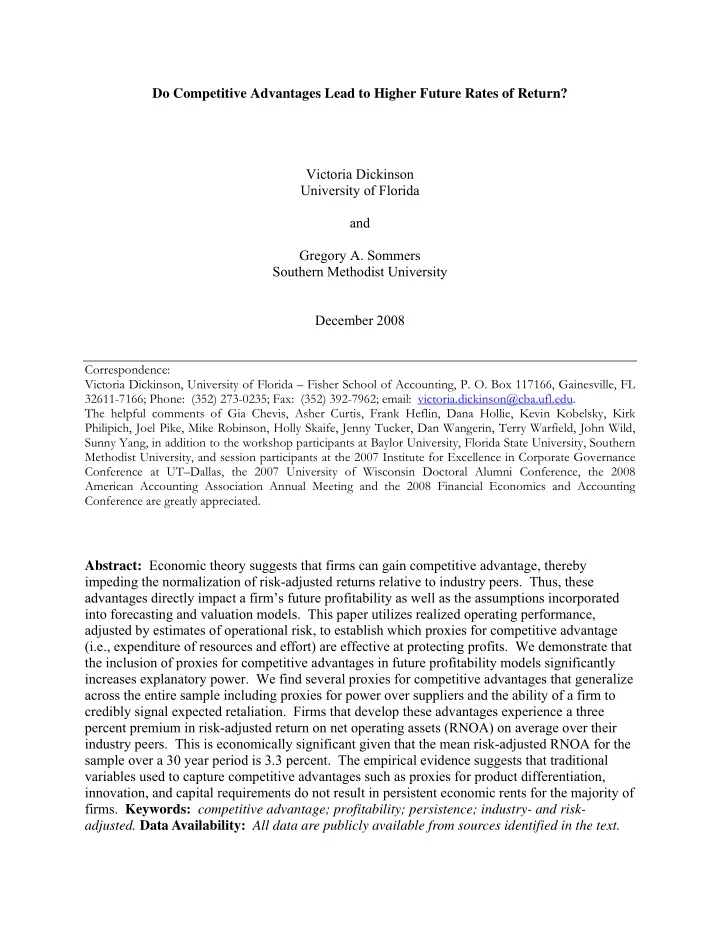

Do Competitive Advantages Lead to Higher Future Rates of Return? Victoria Dickinson University of Florida and Gregory A. Sommers Southern Methodist University December 2008 Correspondence: Victoria Dickinson, University of Florida – Fisher School of Accounting, P. O. Box 117166, Gainesville, FL 32611-7166; Phone: (352) 273-0235; Fax: (352) 392-7962; email: victoria.dickinson@cba.ufl.edu. The helpful comments of Gia Chevis, Asher Curtis, Frank Heflin, Dana Hollie, Kevin Kobelsky, Kirk Philipich, Joel Pike, Mike Robinson, Holly Skaife, Jenny Tucker, Dan Wangerin, Terry Warfield, John Wild, Sunny Yang, in addition to the workshop participants at Baylor University, Florida State University, Southern Methodist University, and session participants at the 2007 Institute for Excellence in Corporate Governance Conference at UT–Dallas, the 2007 University of Wisconsin Doctoral Alumni Conference, the 2008 American Accounting Association Annual Meeting and the 2008 Financial Economics and Accounting Conference are greatly appreciated. Abstract: Economic theory suggests that firms can gain competitive advantage, thereby impeding the normalization of risk-adjusted returns relative to industry peers. Thus, these advantages directly impact a firm’s future profitability as well as the assumptions incorporated into forecasting and valuation models. This paper utilizes realized operating performance, adjusted by estimates of operational risk, to establish which proxies for competitive advantage (i.e., expenditure of resources and effort) are effective at protecting profits. We demonstrate that the inclusion of proxies for competitive advantages in future profitability models significantly increases explanatory power. We find several proxies for competitive advantages that generalize across the entire sample including proxies for power over suppliers and the ability of a firm to credibly signal expected retaliation. Firms that develop these advantages experience a three percent premium in risk-adjusted return on net operating assets (RNOA) on average over their industry peers. This is economically significant given that the mean risk-adjusted RNOA for the sample over a 30 year period is 3.3 percent. The empirical evidence suggests that traditional variables used to capture competitive advantages such as proxies for product differentiation, innovation, and capital requirements do not result in persistent economic rents for the majority of firms. Keywords: competitive advantage; profitability; persistence; industry- and risk- adjusted. Data Availability: All data are publicly available from sources identified in the text.
Do Competitive Advantages Lead to Higher Future Rates of Return? Profits and losses signal the existence of excess supply or demand (Mueller 1986; Stigler 1963). 1 Firms are free to respond to these signals and they enter and exit markets or expand and contract operations until risk-adjusted returns are equalized across firms. However, if firms can establish competitive advantages, this equalization may not obtain, at least in the short run. 2 For this reason, establishment of competitive advantages directly impacts a firm’s future profitability. Moreover, the over-time effect of competitive advantages on profitability impacts the assumptions incorporated into forecasting. 3 Our study uses accounting information to operationalize the measurement of the competitive advantage constructs contained in prior analytical studies. We then measure the association of future profitability with these accounting proxies for competitive advantages. Recent economics literature attempts to define a subset of competitive advantages, specifically barriers-to-entry, and concludes that no single definition or theory is dominant (McAfee et al. 2004; Carlton 2004). A barrier has been defined as an incumbent’s advantage over potential entrants such that persistent profits can be earned without attracting new entrants into the market (Bain 1956). Stigler (1968) defines a competitive advantage as a cost advantage that has accrued to the incumbent. To provide more specificity to the definition of competitive advantages, this paper forms accounting based proxies that capture the theorized advantages. We then examine the association of the proxies with operating performance to establish which expenditures of resources and effort are effective in establishing persistent excess operating profitability over industry peers. 4 Thus, by measuring the connection between expenditures and future operating profitability we can empirically observe whether firms have successfully “created” competitive advantages. 5 Extant research has relied on analytical modeling and/or single industry analyses to study competitive advantages, whereas we simultaneously examine a collective group of potential competitive advantages across all industries. As a result, we are able to specify which competitive advantages successfully elevate risk-adjusted operating profits relative to peers, regardless of industry, for all firms in the Compustat population and to document the persistence of the increased profitability arising from such advantages. That is, we see which efforts beyond those of the firm’s peers would be expected to yield increased profitability. The specific types of competitive advantage addressed in this paper begin with traditional barriers-to-entry such as economies of scale, product differentiation, innovation, and capital requirements. We then expand this commonly used set of variables to include competitive 1 While the economics literature refers to profits and losses, a more precise description is that abnormal profits and losses arise due to supply and demand conditions. 2 van Breda (1981) provides a model showing that in the absence of barriers-to-entry there will be entrants to the industry until the risk-adjusted return to investments is equalized. Where barriers-to-entry exist, he hypothesizes that high barriers will be associated with high rates of return. 3 The ability to forecast future profitability is central to the determination of firm value. Cheng (2005) directly examines the relation of a subset of competitive advantage proxies to future residual income. We build upon his work by expanding the proxies tested while narrowing our scope to focus on future operating profitability rather than firm value. An application of the understanding of the effects of successful competitive advantages on future forecasts from our study could be to improve inputs into various valuation models. 4 As shall be detailed in section 1, our study focuses on the operating portion of the firm rather than the entire firm (i.e. operating and financing portions combined) as has been done in prior research. 5 Presumably some barriers are not created but naturally exist for certain industries. 1
Recommend
More recommend